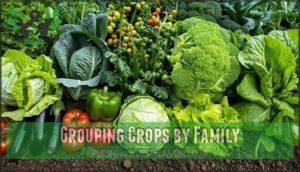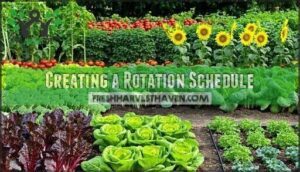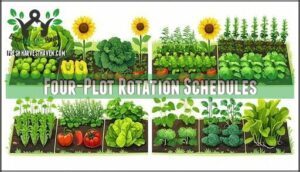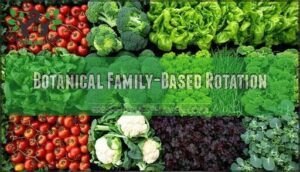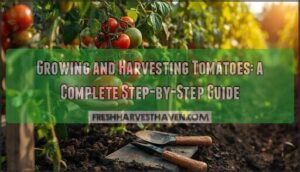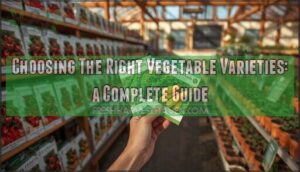This site is supported by our readers. We may earn a commission, at no cost to you, if you purchase through links.
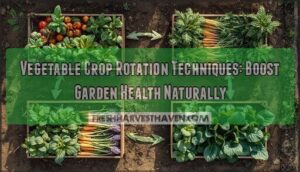
You’ll want to group veggies by plant family, then switch their spots each season—think of it like musical chairs for tomatoes, beans, and carrots.
Using four separate beds makes rotation a breeze, ensuring you never plant the same family in the same bed more than once every four years.
This method breaks pest cycles, balances nutrients, and keeps your garden thriving.
If you’re itching to know how to tailor rotation schedules or mix in companion planting, you’ll find a few clever tricks up ahead.
Table Of Contents
- Key Takeaways
- Crop Rotation Basics
- Planning Crop Rotation
- Implementing Crop Rotation
- Crop Rotation Techniques
- Maintaining Crop Rotation
- Frequently Asked Questions (FAQs)
- What are the 5 principles of crop rotation?
- What is the best order for crop rotation?
- What is the best crop rotation strategy?
- What is the 4 crop rotation method?
- Which vegetables need to be rotated?
- What are the best combinations for crop rotation?
- What vegetables don’t need to be rotated?
- What is the 3 way crop rotation system?
- What are the 4 principles of crop rotation?
- How does crop rotation affect irrigation needs?
- Conclusion
Key Takeaways
- Group your veggies by plant family and rotate them through different beds each year to break pest cycles and keep soil healthy.
- Use four separate garden beds so you never plant the same family in the same spot more than once every four years.
- Track your crop rotation and soil health with simple maps or garden journals to avoid repeating mistakes and boost yields.
- Mix in companion planting and cover crops to enrich soil, suppress weeds, and strengthen pest resistance naturally.
Crop Rotation Basics
Crop rotation is the practice of changing which vegetables you plant in each garden area from season to season, preventing the same plant families from occupying identical locations year after year.
This systematic approach breaks pest and disease cycles while maintaining soil fertility, creating a healthier and more productive garden ecosystem, which is the key to a healthier garden.
Definition and Importance
Through strategic crop rotation, you’re basically conducting an orchestra of plants that work together to maintain your garden’s health.
Crop rotation turns your garden into a symphony, each plant playing its part for healthier soil and bigger harvests.
This time-tested practice involves systematically changing where you plant different vegetables each growing season, creating a natural rhythm that benefits both soil and plants.
Crop rotation tackles multiple challenges simultaneously.
Different plant families have varying nutrient requirements, so rotating prevents any single crop from completely depleting specific minerals from your soil.
This cycle disruption also confuses pests and diseases that rely on finding their favorite host plants in predictable locations year after year.
Here’s what effective crop rotation delivers:
- Enhanced soil health through diverse root systems that improve structure and organic matter
- Reduced soil depletion by balancing nutrient extraction across plant families
- Improved nutrient availability as decomposing roots enrich soil naturally
- Natural pest control by breaking insect and disease life cycles
- Greater sustainability through reduced need for fertilizers and pesticides
To maximize yields, consider staggering plantings for a continuous harvest.
Benefits for Soil Health
Your garden’s soil health depends on three fundamental processes that crop rotation optimizes naturally.
Nutrient cycling occurs when different plants contribute varying minerals—legumes add nitrogen while deep-rooted vegetables bring phosphorus from lower soil layers.
This diversity prevents soil nutrient management problems that plague monoculture gardens.
Organic matter increases dramatically through varied root systems and plant residues.
Each crop family deposits different organic compounds, creating rich humus that improves soil structure and water retention.
Clay soils become looser while sandy soils hold moisture better.
Microbial life thrives with diverse plant partners.
Different crops feed distinct soil microorganisms, building a balanced ecosystem underground.
This biological diversity makes nutrients more available to plants while creating natural soil fertility that reduces your need for synthetic fertilizers.
Healthy microbial life literally transforms your soil into a living, breathing foundation.
Pest and Disease Management
Crop rotation acts like changing the locks on your garden’s doors—pests and diseases that counted on finding their favorite host plants suddenly face empty lots.
When you move crops around systematically, you’re disrupting the pest lifecycle and breaking disease patterns before they can establish strongholds.
Here’s how rotation creates natural pest control and disease prevention:
- Disease disruption occurs as soil-borne pathogens lose their preferred host plants and die off without proper nutrition
- Pest management becomes easier when specialized insects can’t complete their reproductive cycles in familiar territory
- Natural controls strengthen as beneficial predators move in to fill ecological niches left by displaced harmful species
- Resistance management improves since pests can’t adapt to constantly changing crop environments
The disease lifecycle breaks down when pathogens can’t find suitable hosts year after year.
This crop diversity strategy transforms your garden into a moving target that’s harder for problems to hit, creating effective disease suppression without chemicals.
Planning Crop Rotation
Planning your crop rotation properly sets the foundation for a healthier, more productive garden.
You’ll need to organize your vegetables into logical groups and create a systematic schedule that maximizes soil health while minimizing pest problems, which is crucial for a healthier garden.
Grouping Crops by Family
Understanding plant families is like knowing which vegetables are cousins – they share similar appetites and enemies. Botanical families group vegetable crops with comparable nutrient cycling needs and vulnerabilities, creating your rotation blueprint.
Nightshades (tomatoes, peppers, eggplant) demand rich soil and face similar blights. Brassicas (cabbage, broccoli, kale) love nitrogen but attract cabbage worms. Legumes (beans, peas) actually improve soil by fixing nitrogen. Cucurbits (squash, cucumbers, melons) sprawl extensively and share powdery mildew issues.
- Map your family benefits: Each plant family offers unique advantages – legumes enrich soil, while proper plant family grouping maximizes pest resistance and determines your ideal rotation length** for healthiest crops.
Creating a Rotation Schedule
Rotation-scheduling mastery begins with dividing your garden into distinct zones or beds. Establish at least three separate areas to accommodate different crop families each growing season. Your schedule length should span three to four years minimum, preventing the same plant family from occupying identical locations consecutively.
Space allocation requires careful consideration of each zone’s size and growing conditions. Match larger areas with heavy-feeding crops like tomatoes, while dedicating smaller sections to compact plants such as herbs. Crop compatibility plays a vital role—avoid placing related families in adjacent zones to minimize cross-contamination risks.
Documentation methods form the backbone of successful rotation planning. Create detailed maps showing which families occupy each zone annually. Simple charts or garden journals work perfectly for tracking crop rotation cycles.
Rotation customization depends on your specific growing conditions and preferences. Crop rotation systems vary from basic three-plot arrangements to complex six-zone rotation schedules. Crop rotation examples include alternating nitrogen-fixing legumes with heavy feeders, then following with root vegetables to complete the cycle. Utilizing raised beds can further assist in creating physical barriers for garden areas.
Considering Soil Nutrient Needs
Soil testing shows exactly what nutrients you’re missing before planting.
Heavy feeders like tomatoes drain nitrogen, while legumes restore it through nitrogen fixation.
This natural crop sequencing cuts your fertilizer needs dramatically.
Follow nutrient management principles: potassium-loving root crops after leafy greens.
Smart planning prevents nutrient depletion and maintains soil fertility without constant amendments.
Implementing Crop Rotation
Once you’ve planned your crop rotation system, it’s time to put it into action across your garden beds.
The key is staying organized and consistent as you move different plant families through their designated zones each growing season, which involves complete concepts of crop rotation and garden management.
Rotating Vegetables by Plant Family
Most gardeners discover that family benefits reveal the secret to sustainable vegetable crop rotation. When you organize your species selection around plant families, you’re working with nature’s blueprint rather than against it.
Plant family determination becomes your roadmap for creating custom rotations that match your garden size and growing goals. Different plant families share similar nutrient needs, pest vulnerabilities, and soil preferences, making rotation length planning more predictable.
Here’s how plant family list organization transforms your crop rotation systems:
- Solanaceae (tomatoes, peppers, potatoes) – heavy nitrogen feeders requiring 3-4 year breaks
- Brassicaceae (cabbage, broccoli, kale) – prefer cooler weather and well-draining soil
- Leguminosae (beans, peas) – naturally fix nitrogen while growing
- Apiaceae (carrots, parsley, celery) – light feeders that improve soil structure
This vegetable crop rotation approach prevents related plants from depleting identical nutrients while breaking pest cycles that target specific botanical groups. Consider also staggering plantings for a continuous harvest.
Using Multiple Beds or Zones
If you’re aiming for smooth crop rotation, Zone Division is your secret weapon.
Set up four garden beds—each a separate zone—then shift plant families through them yearly.
This kind of Spatial Planning boosts Rotation Efficiency and keeps soil healthy.
Bed Preparation becomes a breeze, and your Garden Layout stays organized.
Vegetable gardening feels less like guesswork and more like strategic garden planning with multiple beds.
Effective crop rotation planning involves using a crop rotation planner to optimize garden productivity.
Incorporating Cover Crops and Weeds
Nature’s own repair crew—cover crops and select weeds—play a vital role in crop rotation.
Cover crops and even some weeds quietly rebuild your soil, keeping your garden thriving season after season.
By weaving these plants into your garden’s rhythm, you boost Soil Enrichment, Weed Suppression, and overall Ecosystem Balance. Cover Crop Benefits go beyond just filling space; they improve soil health, encourage Crop Diversity, and support weed management.
Try these proven strategies:
- Plant crimson clover between vegetable cycles for natural nitrogen fixation and improved soil structure.
- Sow buckwheat for fast ground coverage, phosphorus mobilization, and attracting pollinators.
- Till green manure into your beds before planting to increase organic matter and microbial activity.
- Grow rye grass to suppress weeds using allelopathic effects that limit weed seed germination.
Companion planting with cover crops guarantees resilient, productive soil.
Crop Rotation Techniques
You’ll find several crop rotation techniques that help balance soil nutrients and control pests.
By organizing your vegetables into sequences like leaf, fruit, root, and legume, or using four-plot and family-based rotations, you can keep your garden productive year after year.
Leaf, Fruit, Root, Legume Sequence
When you rotate leafy greens, fruiting vegetables, root vegetables, and legumes in sequence, you’re building a powerhouse for Soil Nutrients and Crop Diversity.
Leafy greens gobble up nutrients, fruiting vegetables follow with moderate needs, and root vegetables loosen soil while scavenging leftovers. Legumes finish the cycle, fixing nitrogen and prepping soil for the next round.
This crop rotation strategy boosts Garden Productivity, supports Sustainable Harvesting, and keeps Farm Planning simple. It’s like giving your garden a yearly tune-up, confusing pests and keeping soil healthy for bigger harvests.
By using effective soil preparation techniques, gardeners can further enhance the benefits of crop rotation and create a thriving ecosystem.
Four-Plot Rotation Schedules
Building on the leaf, fruit, root, and legume sequence, four-plot rotation schedules make crop rotation techniques simple and effective.
Divide your space into four plots, then use soil mapping and crop sequencing to rotate legumes, brassicas, roots, and nightshades each year.
This method boosts soil health, reduces pests, and keeps nutrients balanced.
With careful plot planning and a smart garden layout, you’ll master rotation cycles and see stronger, more productive vegetable crop rotation results.
By implementing a crop rotation plan, gardeners can optimize their soil health and yields, achieving a more productive vegetable outcome.
Botanical Family-Based Rotation
Ever wondered why your tomatoes and peppers keep getting the same pests year after year? That’s where Botanical Family-Based Rotation comes in.
By grouping crops according to their vegetable crop families, you break up pest and disease cycles tied to specific botanical relationships. This crop family rotation method leverages Family Grouping and Nutrient Cycling, making your crop sequencing more systematic.
Here’s how you can master it:
- Group vegetables by plant families—think nightshades, brassicas, and legumes.
- Rotate each family through different beds every 3–4 years for ideal Soil Replenishment.
- Sequence heavy feeders after legumes to maximize Botanical Diversity and nutrient benefits.
This approach keeps soil healthy and productive, while preventing disease buildup. You’ll notice fewer pests, richer soil, and more robust harvests, all thanks to botanical diversity.
Maintaining Crop Rotation
You’ll need to monitor each planting season closely to keep your crop rotation on track, making notes about what goes where and how the soil responds.
Consistent tracking helps you prevent repeating mistakes, ensuring your garden stays productive and your soil remains healthy year after year.
Tracking and Recording Progress
After mastering crop rotation techniques, it’s time to put your garden’s story on paper.
Use Crop Logs, Garden Maps, and Progress Charts to track where each vegetable thrived. Keep garden journals for pest records and nutrient amendments, jotting down details like harvest weights and planting dates.
Record Keeping turns garden notes into valuable data for future planning. Quarterly Soil Testing helps you adjust fertilization, while garden documentation reveals patterns over seasons.
Treat garden performance tracking like a detective game—each clue helps you solve the puzzle of healthier soil and better yields. Accurate garden logs require tracking garden log information to inform future crop rotations.
Monitoring Soil Health and Adjusting
With every crop rotation, keeping your garden’s soil health on track is key.
Soil Testing twice a year helps you spot issues early, like unbalanced Nutrient Balance or drifting pH Levels.
If Microbial Activity drops, toss in compost or switch up crops.
Fertility Management isn’t guesswork—track yields and adjust as needed.
Accurate soil analysis requires using a soil test kit.
Here’s your checklist:
- Test pH levels every six months
- Check nutrients after each cycle
- Track yields
- Assess microbial activity
- Evaluate soil texture changes
To ensure the best results, remember that Soil Testing is crucial for maintaining a healthy garden.
Using Companion Planting for Enhanced Benefits
After tracking soil health, boost results with companion planting.
Pairing Companion Crops like basil and tomatoes cuts thrip damage, while marigolds slash nematode numbers and attract pollinators.
Plant Partners such as legumes fix nitrogen, enriching soil for heavy feeders.
Crop Diversity supports Garden Synergy, suppresses weeds, and strengthens soil health.
Cover crops add extra nitrogen fixation and soil enrichment, which is a key part of companion planting and helps with soil health.
Frequently Asked Questions (FAQs)
What are the 5 principles of crop rotation?
Picture your garden as a chessboard: rotate crops to disrupt pest cycles, balance soil nutrients, boost organic matter, enhance biodiversity, and suppress weeds.
You’ll outsmart soil-borne diseases and keep your harvests healthy season after season.
What is the best order for crop rotation?
Start with legumes to boost nitrogen, then plant leafy greens, followed by fruiting crops like tomatoes, and finish with root vegetables.
This order keeps soil balanced, reduces pests, and gives each crop what it needs, ensuring a complete and healthy harvest.
What is the best crop rotation strategy?
You’ll get the best results by rotating crops in four groups: legumes, alliums, nightshades, and brassicas.
This strategy balances nutrients, disrupts pest cycles, and keeps your soil healthy for years—think of it as garden chess.
It ensures a healthy soil for years.
What is the 4 crop rotation method?
Imagine juggling four crop families—legumes, alliums, nightshades, and brassicas—across your garden beds each year.
You’ll break pest cycles, boost soil health, and keep your harvests thriving, all with scientific precision and a gardener’s flair.
Which vegetables need to be rotated?
You’ll want to rotate tomatoes, potatoes, onions, garlic, carrots, beans, peas, squash, lettuce, and cabbage.
These veggies attract specific pests and diseases, so moving them around helps keep your soil healthy and productive.
What are the best combinations for crop rotation?
Mix things up by rotating legumes with leafy greens, then follow with fruiting crops and root veggies.
This combo keeps soil nutrients balanced, disrupts pest cycles, and helps you dodge the dreaded soil fatigue.
What vegetables don’t need to be rotated?
Herbs like mint, thyme, and rosemary don’t need strict rotation since they’re less prone to soil-borne diseases.
You can also keep perennial vegetables, like asparagus and rhubarb, in the same spot year after year.
What is the 3 way crop rotation system?
The 3-way crop rotation system splits your garden into root crops, brassicas, and everything else.
You’ll rotate these groups yearly, breaking pest cycles, managing soil nutrients, and keeping your harvests healthier and more productive.
What are the 4 principles of crop rotation?
Rotate crops to break pest cycles, balance soil nutrients, boost organic matter, and increase biodiversity.
You’ll keep soil healthy, prevent disease buildup, and get better harvests—think of it as giving your garden a fresh start each season.
How does crop rotation affect irrigation needs?
Don’t put all your eggs in one basket—crop rotation helps you manage irrigation by balancing water needs across different crops.
You’ll find soil holds moisture better, reducing runoff and making watering more efficient season after season, which is a key benefit of managing irrigation.
Conclusion
Balancing science and tradition, vegetable crop rotation techniques let you outsmart pests while nourishing your soil.
By grouping crops by family and switching beds each season, you disrupt pest cycles and keep nutrients balanced. You don’t need fancy tools—just a notebook and some planning.
Over time, you’ll notice healthier plants and fewer problems. Stick with these methods, and your garden will reward you with robust harvests year after year.
Rotation isn’t magic, but it sure feels like it.

